What Does Dna Do To Determine A Cell's Makeup
How Does DNA Work?
DNA is an information storage molecule that lives within almost every cell in the body. If we think of our genome as the recipe book, then chromosomes are chapters, and genes are recipes.
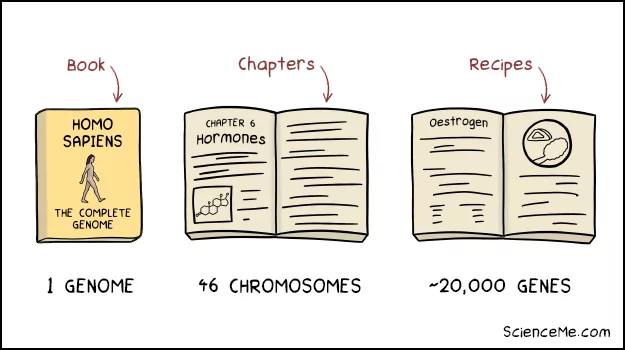
What is Deoxyribonucleic acid? Deoxyribonucleic acid is the chemical that encodes our entire biological blueprint.
What tin we make with these genetic recipes? Merely the well-nigh succulent, life-sustaining proteins, such as hormones, antibodies, and enzymes.
Taking the grade of a double helix, Deoxyribonucleic acid is made up of two strands of complementary base of operations pairs known as A, T, C, and M.
Human Dna contains iii billion base pairs. However, only a tiny fraction of these are protein-coding genes. An individual gene ranges in length from a few hundred bases to more 2 million.
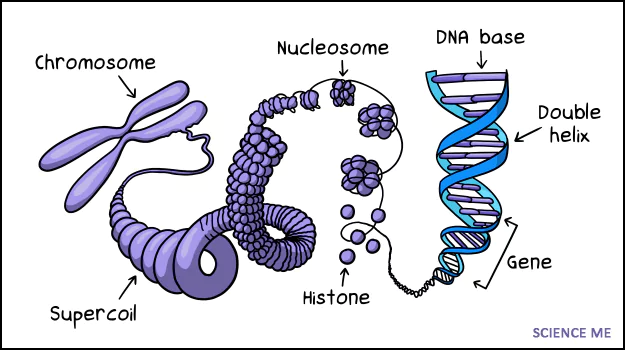
The DNA double helix. Genes are long sequences of base pairs within DNA, which is arranged into chromosomes when cells separate.
The structure of Deoxyribonucleic acid was intuited 70 years agone, based on just a scattering of clues being applied to the rules of chemical bonding.
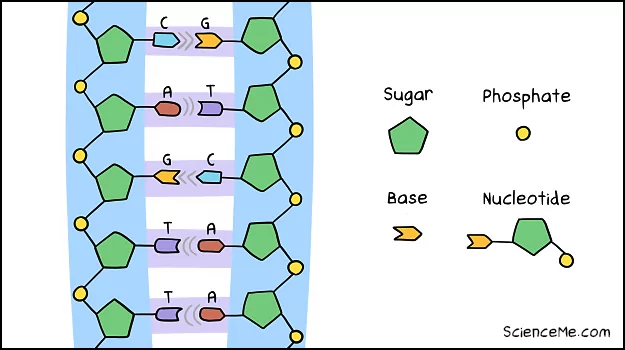
The structure of Dna. The double helix is rulebound and repetitive—it'southward the precise sequence of bases that creates genetic multifariousness. In The Mysterious World of The Human Genome, Frank Ryan offers the illustration of a train track that stretches to the horizon, with three billion sleepers representing base pairs.
Base of operations pairing of Dna is extremely reliable. But mistakes exercise occur—at an estimated charge per unit of 1 in 100 million bases per generation in humans. This is how we go mutations which alter our genetic code.
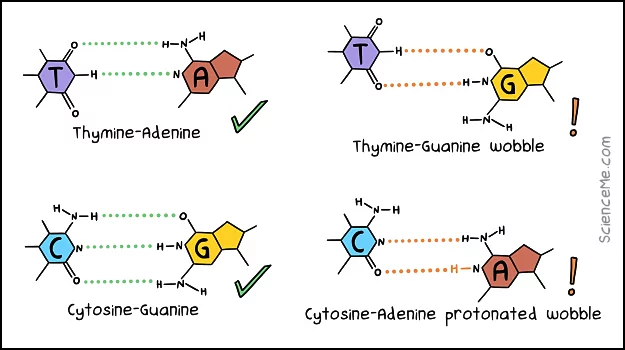
Correct pairing and mispairing between DNA bases. Occasionally, bases can form hydrogen bonds betwixt the wrong atoms, or gain an extra proton to create a protonated wobble. The wrong base can corrupt the entire cistron sequence that follows.
How Does DNA Work?
At present that we have an idea of the construction, how does DNA work? How does it keep us live on a moment-to-moment basis?
Permit'due south zoom out to our cells: the multipurpose biological factories that brand upwards our tissues. Cells take complex internal structures bustling with organelles and proteins that keep united states of america alive.
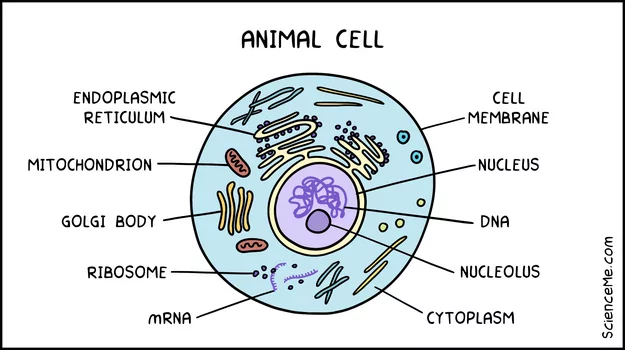
The bones features of an animal prison cell. Our Deoxyribonucleic acid is stored in the nucleus, informing the production of proteins in the cytoplasm.
Besides water and fat, our bodies are made almost entirely of proteins. They include enzymes that drive digestion, hormones that coordinate growth, and antibodies that neutralise invading pathogens.
Dna isn't merely a blueprint for foetal growth. It'southward essential to our ongoing survival, such as making insulin if nosotros've just had breakfast, or cortisol to regulate our stress response.
To make new proteins, specific genes from our primary Dna must starting time exist copied into single-stranded molecules of messenger RNA (mRNA). They exit the nucleus and make their style to the factory floor, better known as the cytoplasm.
It'southward hither that mRNA is translated into long chains of amino acids called peptides. These complex molecules twist and fold into specific functional proteins. The correct Deoxyribonucleic acid blueprint must be followed accurately for proteins to do their jobs around the body.

What does DNA do? The main job of DNA is to store the biological blueprint for making proteins. When the pattern mutates, it can cause harmful diseases or beneficial adaptations.
How exactly is Dna used to make proteins? I promise you lot're sitting down, because here comes an exquisite fleck of molecular biology.
The Fundamental Dogma of DNA Expression
The Central Dogma describes the one-manner menses of genetic data from Dna to proteins. We're going to examine three major stages hither: transcription, processing, and translation.
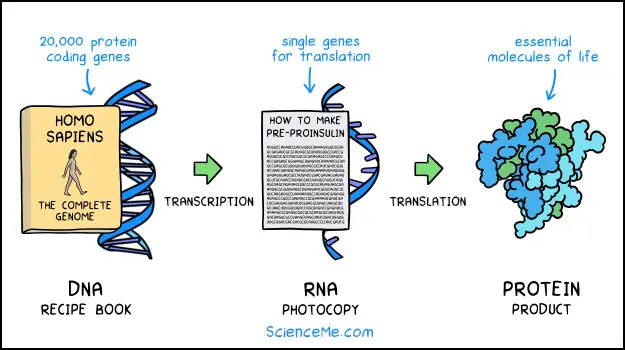
The Central Dogma of Dna expression describes the one-way menstruum of genetic information from DNA to proteins.
Fun fact: the molecular workers involved in this process are themselves made of single-stranded RNA. Various different RNAs tin fold in on themselves to form unique structures and catalyse reactions involving Dna. Don't worry, we're only going to meet two of them on our journey today: messenger RNA and transfer RNA.
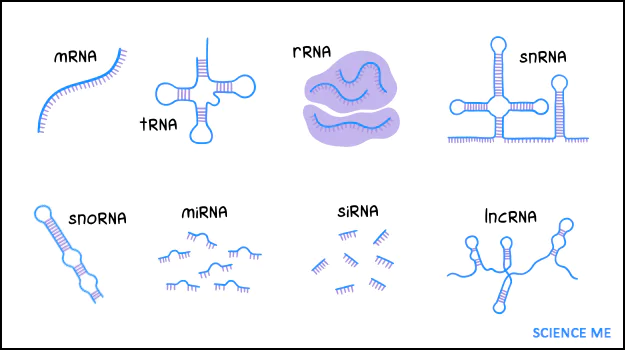
Types of RNA in cells. Dissimilar RNAs have different roles in maintaining and expressing Deoxyribonucleic acid. Here we see messenger (mRNA), transfer (tRNA), ribosomal (rRNA), modest nuclear (snRNA), pocket-size nucleolar (snoRNA), micro (miRNA), modest interfering (siRNA), and long not-coding (lncRNA).
Step 1. Transcription
Then you've got a bunch of DNA hanging around in the nucleus. It'south fourth dimension to express some genes.
A dedicated protein known equally RNA polymerase attaches itself to the DNA. It teases apart the 2 strands of the double helix, unwinding the ladder as it travels forth the length of a gene.
This exposes the Deoxyribonucleic acid anti-sense strand, which contains complementary bases according to the Dna sense strand.
The RNA polymerase multitasks. Equally it unwinds the DNA, information technology reads the individual bases, and builds a new molecule based on complementary pairing.
The ingredients are costless-floating nucleotides: A, T, C, and G bases with a sugar-phosphate courage attached. The emerging genetic string is called pre-messenger RNA.
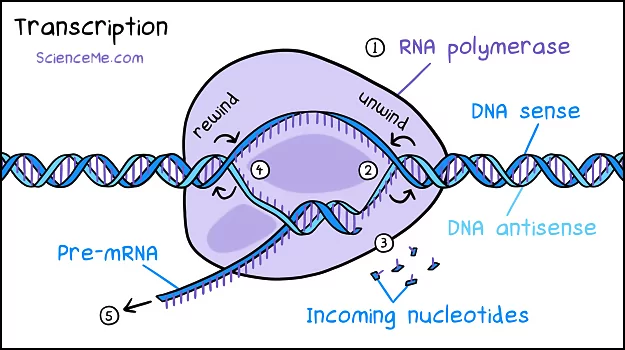
How Deoxyribonucleic acid transcription works. (ane) In initiation, RNA polymerase binds to a promoter sequence at the kickoff of a gene and (2) unwinds the double helix to expose the anti-sense strand. (3) In elongation, RNA polymerase reads the Dna template ane base at a time, amalgam a pre-mRNA transcript from free-floating nucleotides. (4) RNA polymerase re-winds the original strands into a double helix. (5) The pre-mRNA strand is cut loose when RNA polymerase reaches a terminator sequence at the stop of a cistron.
It's a cute molecular dance. And it'southward happening at astonishing speed in your cells right now, all driven by spontaneous chemic interactions.
Step 2. RNA Processing
The Dna recipe book is written in such a way that a single recipe tin can be cut-and-paste to produce multiple culling dishes. The biological term for this is culling splicing.
And so let's customise the dish. Nevertheless within the nucleus, spliceosomes approach the pre-mRNA sequence to brand their edits.
Spliceosomes cut out non-coding sequences of bases called introns and leave behind select coding sequences calledexons.
On average, there are 9 exons per gene, although the supremely long dystrophin factor has 79 exons spanning 2.3 million bases. That'due south some heavy gene editing right there.
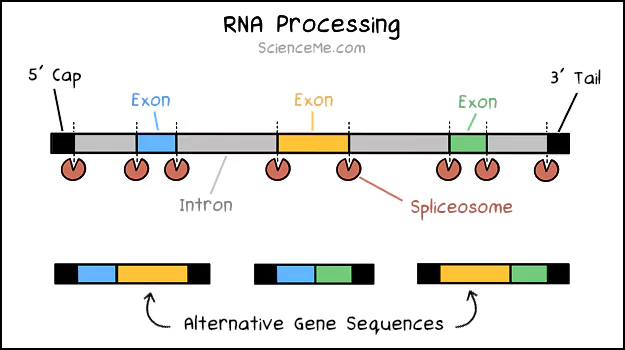
How RNA processing works. Spliceosomes remove non-coding introns from the pre-mRNA strand, leaving simply the desired exons to customise the gene recipe.
Pace 3. Translation
And then far, nosotros've just been tinkering with the factor recipe. Now we need a chef to actually source the ingredients and produce the dish.
The finished messenger RNA strand exits the nucleus and lands in the fluid prison cell cytoplasm. This is the kitchen flooring. Here, a ribosome binds to the get-go of the mRNA and does something remarkable.
Ribosomes read the mRNA in groups of three bases called codons. These are matched to complementary anticodons.
Free-floating transfer RNA units approach the ribosome, each carrying an amino acrid matched to a specific anticodon. Spontaneous chemical bonding sees the mRNA translated into the desired sequence of amino acids.
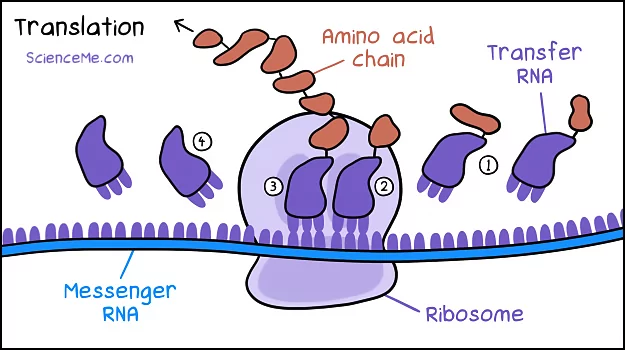
How RNA translation works. (1) Costless-floating tRNAs eolith amino acids at the ribosome. (2) Spontaneous reactions see mRNA codons friction match to their complementary tRNA anti-codons. (3) The ribosome builds a chain of amino acids while (4) cutting the spent tRNA free. The amino acid concatenation is released when the ribosome reaches a terminate codon.
How Amino Acids Create Proteins
Amino acid chains—or peptides—brainstorm with a main structure: a linear cord of amino acids connected by covalent bonds. Just this doesn't terminal long.
During translation, amino acids form weak hydrogen bonds between ane other, twisting and folding the chain into blastoff helices and beta sheets. These are secondary structures.
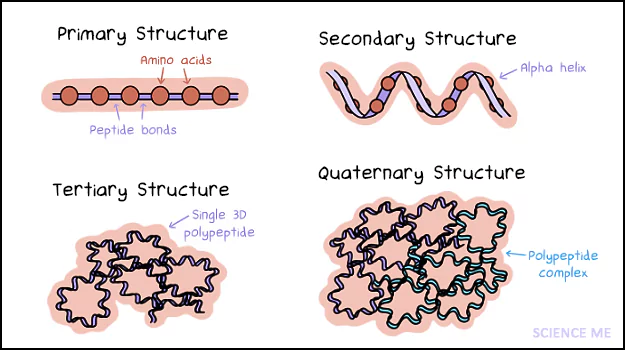
The four levels of protein construction.
Tertiary structures are more than complex yet. As amino acids fold and meet, they spontaneously form ionic bonds, disulphide bridges, and hydrophilic and hydrophobic interactions. This secures them into 3D proteins with unique forms. And when multiple polypeptide bondage convene, they produce the largest of all proteins with complex quaternary structures.
At this bespeak, the new proteins are packaged off to their destination outside the prison cell, or retained inside every bit new cell workers.
The Genetic Code
"Tell me more nearly the codons!" I hear you scream. And you lot'd be correct. This is a good thing to scream about, if anything is.
The RNA alphabet has only four letters (A, U, C, G). Since codons occur in groups of iii, it means in that location are only 64 words in our codon dictionary.
However because human cells can only produce 20 different amino acids, it leaves us with a fair chip of redundancy in the genetic code. In other words, each amino acid tends to be associated with more than one codon.
Genes begin with a starting time codon, the virtually common of which is AUG, which also translates to the amino acrid methionine. So this amino acrid is usually docked offset at the ribosome.
Likewise, genes cease up with a stop codon; either UAG, UGA, or UAA. These don't translate to any amino acids and merely signal the end of the peptide chain.
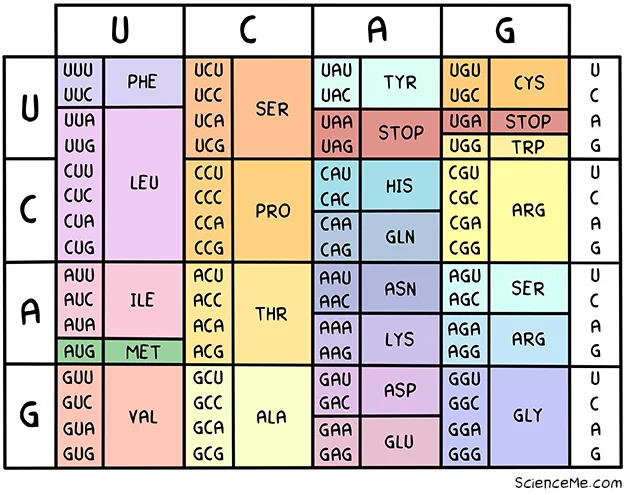
The Codon Tabular array. Each 3-alphabetic character codon refers to the base sequences of A, U, C, and One thousand in RNA. They translate to specific amino acids.
Amino Acid Key
| Ala = Alanine | Leu = Leucine |
| Arg = Arginine | Lys = Lysine |
| Asn = Asparagine | Met = Methionine |
| Asp = Aspartic Acrid | Phe = Phenylalanine |
| Cys = Cysteine | Pro = Proline |
| Gln = Glutamine | Ser = Serine |
| Glu = Glutamic Acid | Thr = Threonine |
| Gly = Glycine | Trp = Tryptophane |
| His = Histidine | Tyr = Tyrosine |
| Ile = Isoleucine | Val = Valine |
How Fast Does Dna Piece of work?
Depending on the size of the gene, it takes betwixt twenty seconds and several minutes to produce a typical protein molecule from mRNA.
Multiple ribosomes tin work along the aforementioned mRNA strand, just 80 nucleotides apart, to produce multiple proteins simultaneously. And in that location are up to 10 million ribosomes in each cell, all building proteins on-need alongside other cells.
It'southward all rather amazing really. Deoxyribonucleic acid and its entourage perform a constant choreography, culminating in the normal operation of whatever living organism, such as a friendly erstwhile toad. Isn't that brilliant?
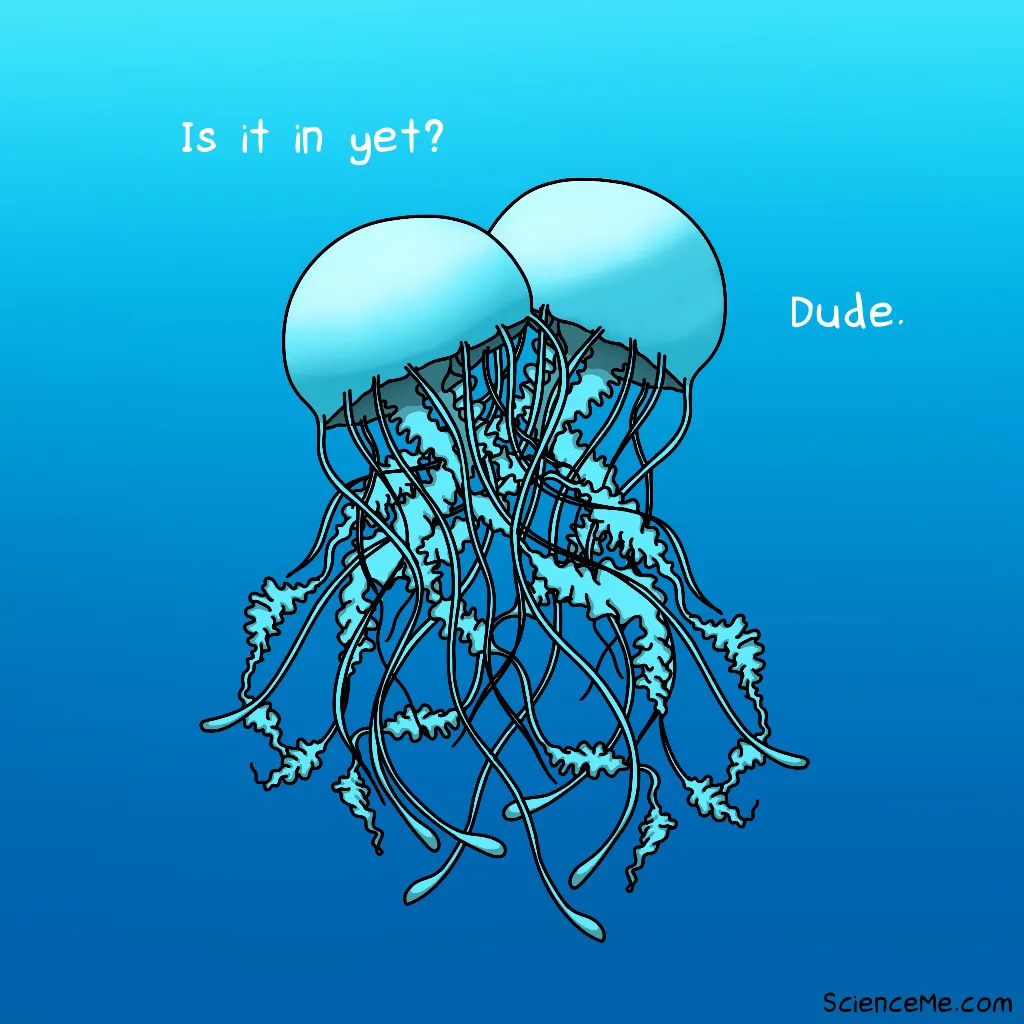
Jellies are ancient animals, mastering sexual reproduction long earlier the states. Frankly, we're the ones odd-balling it with our penises, vaginas, and miserable childbirth... Read more

Viruses are devious wretches that meddle with our biological science. Yous might call them intracellular parasites, mobile genetic elements, or freeloading gits... Read more
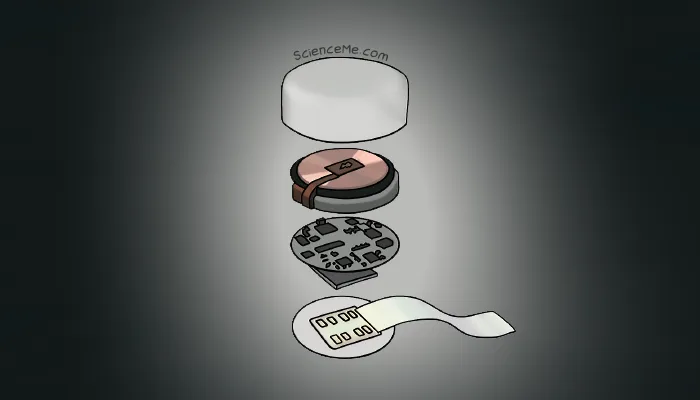
The AI will run our world; non with a Terminator-style robot war, merely with data-derived algorithms making micro and macro decisions on our behalf... Read more

He described Nightfall as an archetypal social scientific discipline fiction, where authors moved abroad from gadgets and towards exploration of the human condition... Read more
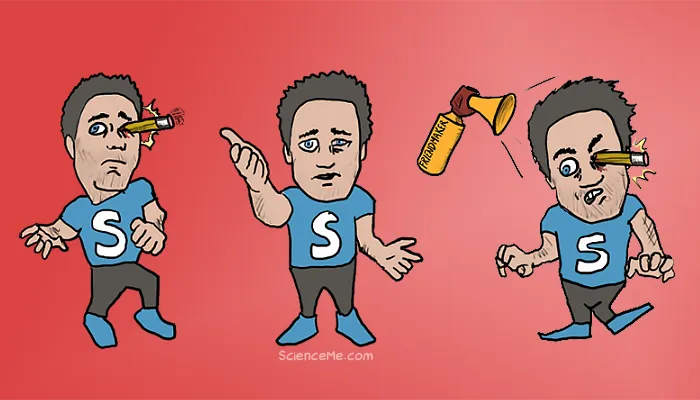
Generalisation is too common in phobias. If you accept an irrational fright of going to the doctor, your feet can as well be triggered by related stimuli... Read more than
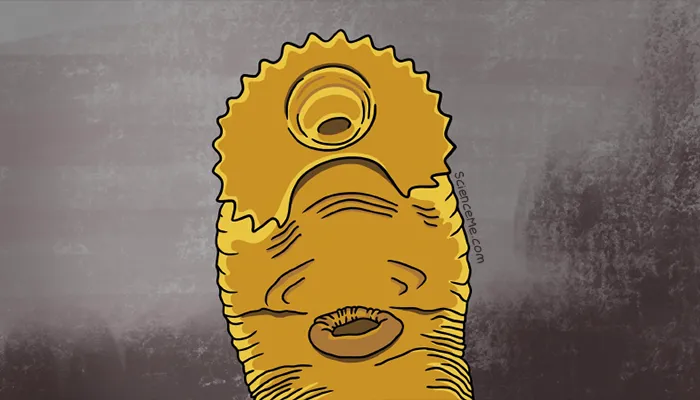
This is Curtuteria australis: a parasitic flatworm that takes over three separate hosts during his convoluted lifecycle. Best of all, he's a card-carrying body-snatcher... Read more
Source: https://www.scienceme.com/how-does-dna-work
Posted by: dorseyfrialking.blogspot.com


0 Response to "What Does Dna Do To Determine A Cell's Makeup"
Post a Comment